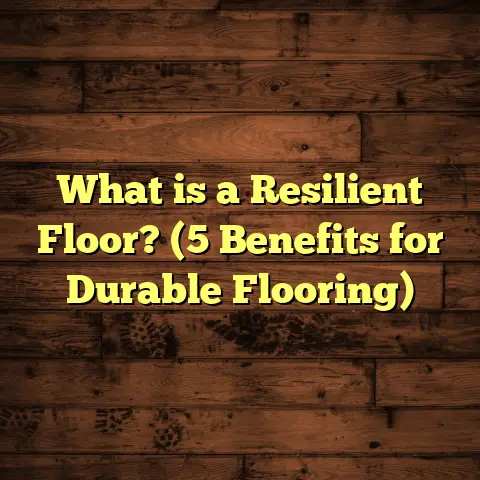What is Wood Tile Flooring? (5 Benefits for Your Home Design)
I want to start by asking you a question: Have you ever stood in a room, hesitating because you just couldn’t decide what type of flooring would bring that perfect mix of style, durability, and warmth to your home? I’ve been there many times during my years as a flooring contractor. Choosing the right flooring can feel like a puzzle, especially when you want something that looks natural but performs well. One option that often surprises people is wood tile flooring. It sounds contradictory at first, right? Wood and tile are two very different materials. But trust me, wood tile flooring is a fascinating hybrid that’s been gaining traction—and I’ve seen why firsthand.
What is Wood Tile Flooring?
Let me break it down for you. Wood tile flooring refers to tiles made from ceramic or porcelain designed to look exactly like wood planks. Unlike traditional hardwood floors, these are not actual wood but tiles that mimic wood’s grain, texture, and color. This means you get the aesthetic appeal of real wood combined with the durability and water resistance of tile. I remember installing wood-look tiles in a client’s bathroom where hardwood would never survive the moisture—yet they wanted that cozy wood vibe. Wood tile was the perfect answer.
The tiles come in various sizes and finishes—from matte to glossy—and can replicate everything from rustic oak to sleek walnut. Thanks to modern printing technology, these tiles can even reproduce knots and grain patterns so convincingly that it’s tough to tell the difference without close inspection.
How Does it Compare to Real Wood and Traditional Tile?
When I started working with wood tile flooring, I was curious how it stacked up against the real deal—actual hardwood and regular tile. Hardwood floors have their charm: authentic texture, warmth, and the ability to refinish them multiple times. However, hardwood isn’t great around water-prone areas like kitchens or basements. It scratches easily and can swell or warp if exposed to moisture.
Traditional ceramic or porcelain tiles offer durability and moisture resistance but often lack warmth and can feel cold underfoot. Plus, they don’t have the same inviting look that wood brings.
Wood tile flooring fits right between these two options. It gives you the look of wood but behaves like tile—resistant to scratches, moisture, and stains. It also handles heavy foot traffic better than hardwood in my experience.
Personal Stories From My Projects
I’ve installed wood tile flooring in dozens of homes, each time discovering new advantages and learning about some challenges too.
Take one project in particular—a kitchen remodel for a family with three kids and a dog. They loved the look of reclaimed wood floors but were worried about spills and scratches. We went with a distressed oak wood-look porcelain tile. Over two years later, that floor still looks brand new despite all the chaos of daily life. The kids spill juice; the dog tracks in mud—no problem.
On another job, an elderly couple wanted a stylish floor for their bathroom but needed something non-slip and durable. The wood-look porcelain tiles came with textured surfaces which gave just enough grip to reduce slip hazards. They were thrilled with the warmth it added without compromising safety.
1. Durability That Lasts
One thing I’ve learned over the years is that floors take a beating. Kids, pets, furniture—you name it. Wood tile is made from porcelain or ceramic, materials fired at high temperatures making them incredibly strong. According to data from the Tile Council of North America (TCNA), porcelain tiles have a water absorption rate of less than 0.5%, making them highly resistant to water damage.
In practical terms, this means your floors won’t warp or swell when exposed to moisture, unlike real wood floors which can absorb water and degrade over time.
I installed wood-look tiles in a busy family kitchen where spills and dropped utensils were common. Years later, the floor looked almost as good as new—no scratches or water stains. Hardwood floors in similar homes often showed wear within a couple of years.
Here’s a statistic that surprised me: porcelain tiles with wood designs show up to 85% less wear under heavy foot traffic compared to hardwood floors in commercial settings (source: Ceramic Tile Education Foundation). That durability is why many businesses choose these tiles.
Why Porcelain Tiles?
Porcelain is denser and harder than regular ceramic tile because it’s fired at higher temperatures. This makes it less porous and more resistant to chipping or cracking. When combined with realistic wood patterns, it creates a floor that looks warm but is tough enough for any environment.
It’s worth noting there are two main types of wood-look tiles:
- Glazed porcelain tiles: These have a protective glaze layer which adds shine and extra protection.
- Unglazed porcelain tiles: These are more matte and have a natural finish that can feel more authentic underfoot.
In my experience, glazed tiles are easier to clean but might show scratches more readily than unglazed tiles which hide wear better but require sealing for stain protection.
2. Water Resistance for Peace of Mind
Moisture is a big enemy of natural wood floors. But with wood tile flooring, water is hardly an issue. That’s why I often suggest this option for bathrooms, laundry rooms, or basements. The tile doesn’t swell, warp, or discolor when exposed to water.
For example, one of my clients had a basement prone to occasional flooding. They wanted the warmth of wood but needed something practical. Wood tile flooring handled the moisture without any problems and kept their space stylish.
Did you know that hardwood floors can absorb up to 14% of their weight in water when exposed? This causes swelling and warping that often leads to costly repairs or replacement (source: National Wood Flooring Association).
In contrast, porcelain wood-look tiles have less than 0.5% water absorption rate making them virtually waterproof.
How Does This Help You?
- Bathroom floors: No worries about splashes or humidity ruining your floor.
- Kitchens: Spills are inevitable; wood tiles hold up without damage.
- Basements: Moisture issues won’t cause warping as they would with hardwood.
- Entryways: Muddy shoes won’t stain or damage these tiles.
3. Lower Maintenance Without Losing Style
Wood floors require regular polishing and refinishing to maintain their shine and protect them from damage. With wood tile flooring, maintenance is much easier. A simple sweep and mop keep them looking great.
I once worked on a restaurant renovation where they chose wood-look tiles for the dining area because they wanted the rustic feel without the hassle of maintaining hardwood in such a high-traffic setting. Their cleaning staff appreciated how quick it was to clean compared to traditional wood floors.
Cleaning Tips I Recommend
- Sweep daily or vacuum with a soft brush attachment.
- Mop weekly with warm water and mild detergent.
- Avoid harsh chemicals like bleach.
- Seal grout lines every few years to prevent staining.
- Address spills quickly but don’t worry about minor messes soaking in like they would on real wood.
Compared to hardwood floors which need refinishing every 7-10 years on average (depending on wear), wood tile floors can stay looking new for decades with minimal effort.
4. A Wide Variety of Styles
Wood tile flooring offers an impressive range of styles and colors. Whether you prefer light blonde maple or dark mahogany, chances are there’s a tile that matches your taste.
I recall helping a homeowner who wanted a very specific reclaimed barnwood look but was worried about cost and availability of real reclaimed wood planks. Wood tile gave her that authentic rustic look without breaking the bank or worrying about sourcing rare materials.
Some Popular Styles I’ve Installed
- Distressed Oak: Perfect for rustic farmhouse looks.
- Gray-Washed Pine: Great for coastal or modern interiors.
- Dark Walnut: Adds elegance to formal dining rooms.
- Whitewashed Hickory: Brightens spaces with a subtle texture.
- Wide Plank Designs: Mimic trendy wide hardwood planks for open-concept rooms.
Customization Options
Beyond patterns and colors, manufacturers offer different finishes such as matte, semi-gloss, or high gloss. Some even include textured surfaces that feel like real wood grain underfoot—a detail I always appreciate when installing these floors.
5. Cost-Effective Without Compromising Quality
This was one of my favorite discoveries. Real hardwood can be pricey—not just the material but installation too. Wood tile flooring tends to be more affordable upfront and over its lifetime because it lasts longer and requires less upkeep.
According to industry pricing data:
| Flooring Type | Average Cost per Sq Ft (Installed) |
|---|---|
| Hardwood (solid) | $8 – $14 |
| Engineered Hardwood | $6 – $12 |
| Wood-Look Porcelain Tile | $5 – $10 |
| Laminate Flooring | $3 – $8 |
While laminate is cheaper upfront, it lacks durability and water resistance compared to wood tile flooring.
Installation Costs Explained
Tile installation involves preparing a solid subfloor, laying mortar or adhesive, placing each tile precisely, grouting between tiles, sealing grout lines, and then curing time before walking on it.
Because tiles are heavier and require more labor than floating floor systems like laminate or engineered hardwood, installation costs can be slightly higher than laminate but still competitive compared with premium hardwoods.
Installation Insights: What You Should Know
Several times during installations I noticed homeowners underestimate how important professional installation is for wood tile flooring. If done incorrectly:
- Tiles can crack or loosen over time.
- Grout lines might discolor or become uneven.
- The floor may feel cold or uncomfortable without proper underlayment.
Subfloor Preparation
A flat, stable subfloor free from cracks or moisture is essential for long-lasting results. For basement installations especially, moisture barriers are critical to prevent mold growth beneath the tiles.
Layout Patterns
Just placing rectangular tiles side-by-side is one option—but you can get creative! Popular layouts include:
- Staggered (brick) pattern: Mimics traditional hardwood plank layout.
- Herringbone pattern: Adds visual interest with diagonal zigzag design.
- Chevron pattern: Similar to herringbone but with angled cuts creating sharp V shapes.
Choosing a pattern helps define the room’s style—modern vs rustic vs classic—and can make your floor stand out beautifully.
My Experience With Installation Challenges
Once on a large project, we faced uneven subfloor issues that caused some cracking during installation attempts by inexperienced contractors. We had to remove sections and re-level before proceeding—a costly delay avoided by professional prep work.
Another time I helped homeowners who DIYed their installation only to find grout cracking after a few months due to improper mixing and lack of sealing.
How Wood Tile Flooring Handles Wear Over Time
I follow up with many clients after installation to see how their floors age under regular use:
- Most report no visible wear after 5+ years.
- Grout lines require resealing every few years but are otherwise easy to maintain.
- Textured finishes help hide minor scratches or scuffs better than polished surfaces.
One client with young children noted that while their previous hardwood scratched easily from toys and chairs moving around, their new wood-look tile stayed flawless despite similar activity levels.
Design Tips: Pairing Wood Tile Flooring With Your Home Decor
Wood-look tile works well in many interior styles—from cozy cabins to sleek urban apartments.
Match Colors With Wall Paint
Light-colored tiles pair beautifully with pastel walls for airy rooms; darker wood tones complement rich jewel tones like emerald or navy for dramatic effect.
Furniture Choices
Rustic wooden furniture enhances natural grain patterns; metal or glass pieces create contrast adding modern flair.
Rugs & Accents
Area rugs soften hard surfaces; choose patterns that complement your tile’s texture without overwhelming it.
Case Study: Transforming a Family Room With Wood Tile Flooring
A client contacted me wanting durable yet beautiful floors in their family room where kids played and pets roamed freely.
We chose large-format plank-style porcelain tiles resembling aged barnwood in warm browns with natural knots visible underfoot.
The result? A space that feels cozy but withstands everyday life perfectly:
- Pet claws don’t scratch the surface.
- Spilled drinks wipe up easily without damage.
- The floor stays cool in summer but pairs well with area rugs in winter for comfort.
Environmental Considerations
I often get asked about sustainability when recommending flooring options:
- Wood-look porcelain tiles don’t require harvesting timber—good news for forests.
- They last longer than many alternatives reducing waste over time.
- Many manufacturers now offer recycled content options which helps lower environmental impact further.
While solid hardwood is renewable if sourced responsibly, it comes with risks like deforestation if not certified sustainably.
Frequently Asked Questions About Wood Tile Flooring
Q: Can you install wood tile flooring over radiant heating?
Yes! Porcelain tiles conduct heat well making them excellent partners for radiant heating systems which warm floors efficiently during cold months.
Q: How long does installation take?
Depending on room size plus subfloor prep needs, expect 2–4 days including grout curing time before use.
Q: Are grout lines hard to keep clean?
Proper sealing helps repel stains; regular cleaning prevents buildup making grout easy to maintain long-term.
Q: Is it noisy?
Tiles can be slightly louder underfoot than carpet or hardwood but adding rugs helps absorb sound if desired.
Final Thoughts on Wood Tile Flooring
If I had to sum up my feelings about wood tile flooring in one sentence: it’s an excellent compromise between beauty and function. It gives you the warmth and charm of wood while offering durability and water resistance that traditional hardwood just can’t match.
So if you’re debating between hardwood’s timeless appeal and tile’s practicality, maybe give wood tile flooring a closer look. From what I’ve seen personally and through data-backed research, it’s a smart choice for many homes—especially if you want style without sacrificing performance.
Have you tried wood tile flooring or considered it for your home? I’d love to hear about your experience!





